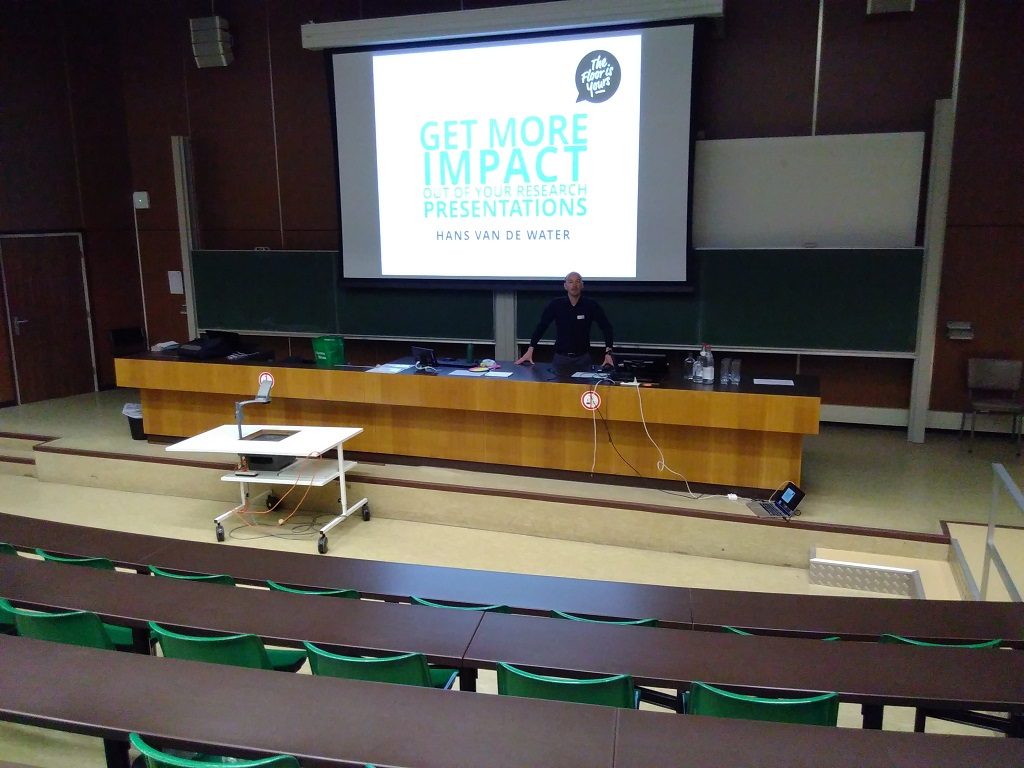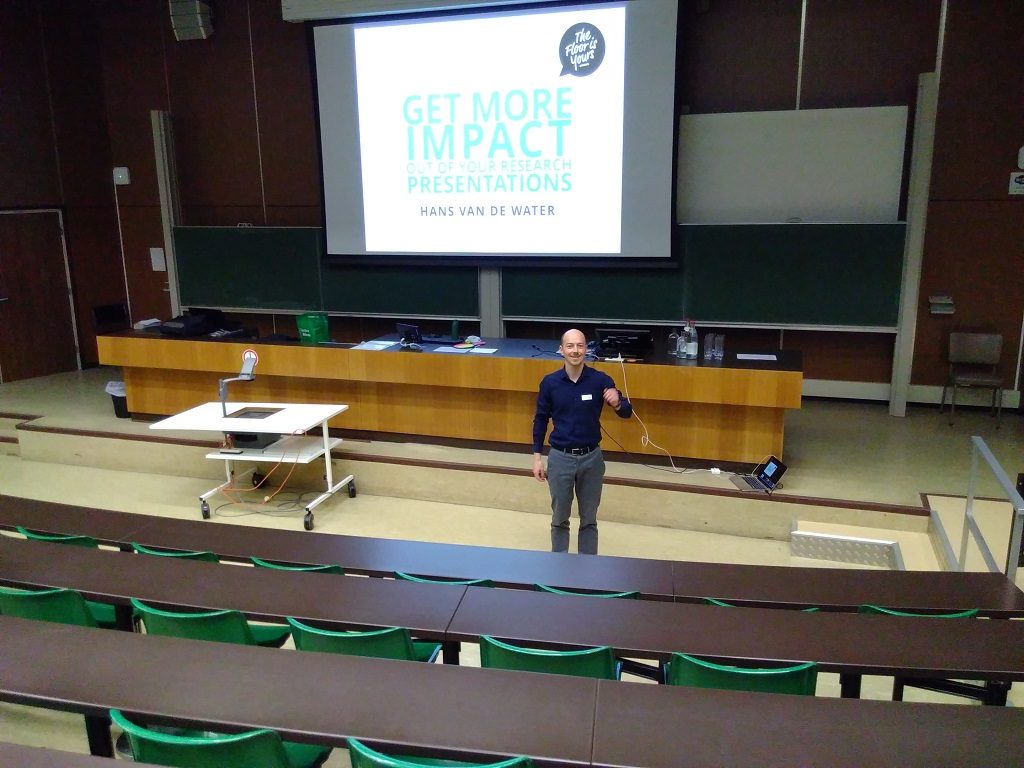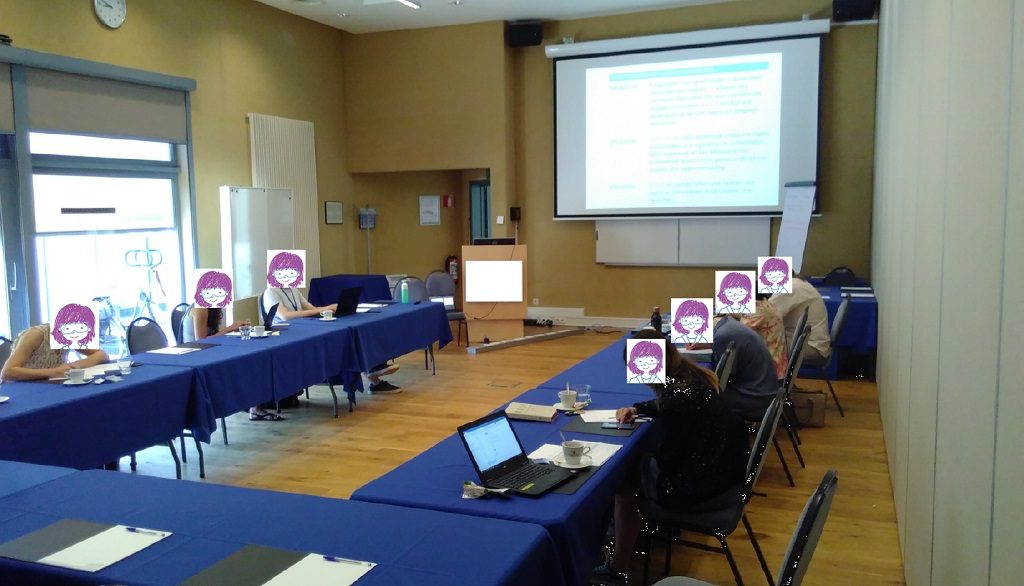Take your place front and center
Giving a talk takes courage. The spotlight is on you, and instinctively many presenters simply want to hide away behind their laptop or lectern. Away from the spotlights.
If we could give one ultimate performance tip, (aside from always wearing a smile), it would be: Take your place front and center.
Try to stand as much in the center and to the front of the stage.
Not behind a table, not tucked away against the screen, not hidden behind a lectern. Front and center.
Compare the two photos below. In the first photo, Hans is standing where most people position themselves: behind the tables. Close to the screen, with a clear view of his computer monitor. In the second photo, Hans stands in front of the tables, making himself much more present and all the more visible. Clearly the better option.


Tip: Because computer monitors are often directed toward presenters who do stand behind the tables, you will likely need to make a small adjustment there. My workaround is placing a chair in the mid-aisle, on top of which I place my laptop. That way I can still view my computer monitor while standing as much front and center in the room. (In this picture, Hans has put his computer on the ground, bottom right)
Problem 1: you have to stand behind a lectern
At times it may seem impossible to stand front and center. The main culprit being the lectern. The participants of a recent workshop shared with me they had no other choice than to stand behind a lectern: “At our PhD Day there is only a lectern fitted with a microphone and that is where we are asked to stand.”
But that may not be your only option: you could in fact take place behind the lectern, but you could also choose not to. And I do realize that second option takes courage.
One week later I happened to be presenting a workshop at the venue where that exact PhD Day would be taking place.

And take it from me: by not standing behind that lectern, you are sure to double your impact. If you are one of the few persons standing front and center, you are bound to draw your audience’s attention.
Or to put it in the words of Joke Dams, postdoc researcher at the University of Ghent’s Department of Linguistics and Philosophy, who recently e-mailed us:
“I even had the nerve to ask to wear a wireless microphone. I ended up being the only speaker to not be tucked away in a small corner behind the lectern, but to actually be able to move about. That sure woke up the audience.”
Problem 2: you won’t have a microphone
As an excuse, you’ll often hear that the lectern is the only place fitted with a microphone, but that is not always true. At the workshop venue from the example mentioned above, the lectern even turned out to contain two headsets and a wireless microphone.
As an invited speaker, don’t be afraid to ask for a microphone that will allow you to move about on stage. This could be a handheld microphone, a lavalier microphone or a headset. Plenty of options available.
Tip: Another place where you will often find a microphone is with the jury. Because the jury members share a microphone, this will often turn out to be a handheld one. Don’t hesitate to ask the organizers (or the jury) beforehand if you could use that microphone during your presentation. Of course, don’t forget to quickly return it in time for feedback.
And finally, a call to event organizers: make sure to provide your speakers with a microphone if you are expecting an audience of 25 or more. One they can actually walk around with. Does your organization not have one available? Why not rent one?
Organising in Belgium? You may even qualify to make use of your province lending service. They often have handheld microphones or headsets on loan for just a small fee.
(links in Dutch)
- Lending service province of Antwerp
- Lending service province of Limburg
- Lending service province of East Flanders (Oost-Vlaanderen)
- Lending service province of Flemish Brabant (Vlaams-Brabant)
- Lending service province of West Flanders (West-Vlaanderen)
- Lending service Brussels
Make sure to do this. It will allow your presenters to stand exactly where they should be standing: front and center.